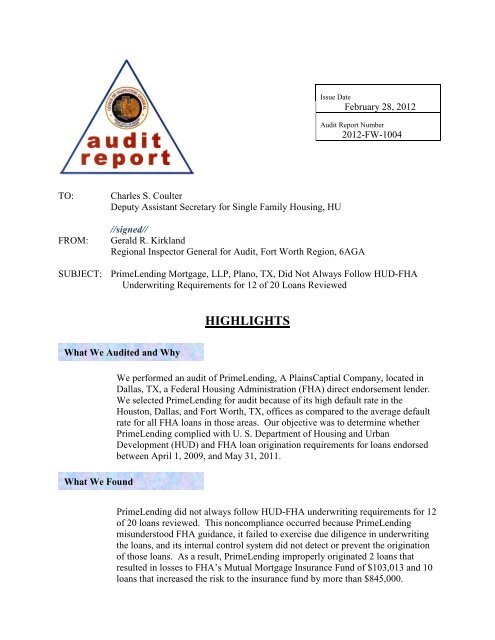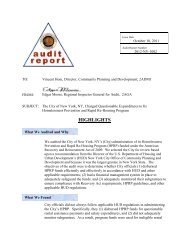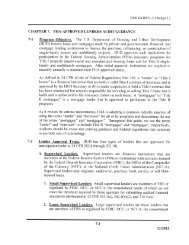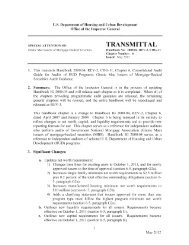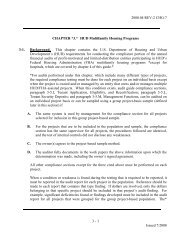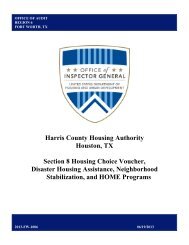Herman Ransom, Director, Office of Multifamily Housing - Hud-Oig
Herman Ransom, Director, Office of Multifamily Housing - Hud-Oig
Herman Ransom, Director, Office of Multifamily Housing - Hud-Oig
You also want an ePaper? Increase the reach of your titles
YUMPU automatically turns print PDFs into web optimized ePapers that Google loves.
Issue DateFebruary 28, 2012Audit Report Number2012-FW-1004TO:FROM:Charles S. CoulterDeputy Assistant Secretary for Single Family <strong>Housing</strong>, HU//signed//Gerald R. KirklandRegional Inspector General for Audit, Fort Worth Region, 6AGASUBJECT: PrimeLending Mortgage, LLP, Plano, TX, Did Not Always Follow HUD-FHAUnderwriting Requirements for 12 <strong>of</strong> 20 Loans ReviewedHIGHLIGHTSWhat We Audited and WhyWhat We FoundWe performed an audit <strong>of</strong> PrimeLending, A PlainsCaptial Company, located inDallas, TX, a Federal <strong>Housing</strong> Administration (FHA) direct endorsement lender.We selected PrimeLending for audit because <strong>of</strong> its high default rate in theHouston, Dallas, and Fort Worth, TX, <strong>of</strong>fices as compared to the average defaultrate for all FHA loans in those areas. Our objective was to determine whetherPrimeLending complied with U. S. Department <strong>of</strong> <strong>Housing</strong> and UrbanDevelopment (HUD) and FHA loan origination requirements for loans endorsedbetween April 1, 2009, and May 31, 2011.PrimeLending did not always follow HUD-FHA underwriting requirements for 12<strong>of</strong> 20 loans reviewed. This noncompliance occurred because PrimeLendingmisunderstood FHA guidance, it failed to exercise due diligence in underwritingthe loans, and its internal control system did not detect or prevent the origination<strong>of</strong> those loans. As a result, PrimeLending improperly originated 2 loans thatresulted in losses to FHA’s Mutual Mortgage Insurance Fund <strong>of</strong> $103,013 and 10loans that increased the risk to the insurance fund by more than $845,000.
What We RecommendFurther, Prime Lending caused HUD-FHA to pay $110,343 in claims on eightineligible loans.Auditee’s ResponseWe recommend that the Deputy Assistant Secretary for Single Family <strong>Housing</strong>require PrimeLending to (1) reimburse the FHA insurance fund $103,013 inactual losses on 2 loans; (2) indemnify 10 loans that placed the FHA insurancefund at unnecessary risk with unpaid balances <strong>of</strong> more than $1.6 million, therebyputting an estimated $845,763 1 in funds put to better use; (3) repay $110,343 inclaims paid on 8 loans; and (4) ensure that it accurately enters information intoHUD’s Neighborhood Watch system and correct the data errors cited in thisreport.For each recommendation without a management decision, please respond andprovide status reports in accordance with HUD Handbook 2000.06, REV-4.Please furnish us copies <strong>of</strong> any correspondence or directives issued because <strong>of</strong> theaudit.We provided our discussion draft to PrimeLending on January 24, 2012, and heldthe exit conference on January 31, 2012. PrimeLending provided its response onFebruary 9, 2012. PrimeLending generally disagreed with the findings.The complete text <strong>of</strong> the auditee’s response, along with our evaluation <strong>of</strong> thatresponse, can be found in appendix B <strong>of</strong> this report.1According to the Single Family Acquired Asset Management System’s case management pr<strong>of</strong>it and loss byacquisition as <strong>of</strong> September 2010, FHA’s average loan loss experience is about 59 percent <strong>of</strong> the unpaidprincipal balance upon sale <strong>of</strong> a mortgaged property.2
TABLE OF CONTENTSBackground and Objective 4Results <strong>of</strong> AuditFinding:PrimeLending Did Not Always Follow HUD-FHA UnderwritingRequirements for 12 <strong>of</strong> 20 Loans Reviewed5Scope and Methodology 11Internal Controls 12AppendixesA. Schedule <strong>of</strong> Questioned Costs and Funds To Be Put to Better Use 13B. Auditee Comments and OIG’s Evaluation 14C. Summary Data for Loans Reviewed 28D. Case Narratives 293
BACKGROUND AND OBJECTIVEPrimeLending, a PlainsCapital Company, is a residential mortgage originator licensed tooriginate and close loans in 50 States and the District <strong>of</strong> Columbia. As <strong>of</strong> December 31, 2010, itoperated from 205 locations in 33 States. PrimeLending was approved by the U. S. Department<strong>of</strong> <strong>Housing</strong> and Urban Development (HUD) to originate Federal <strong>Housing</strong> Administration (FHA)-approved mortgage loans on February 13, 1990. It primarily originates single-family residentialloans to customers in its 205 <strong>of</strong>fices. After originating loans, PrimeLending sells the loans onthe secondary market; thus, it does not service the loans.HUD’s direct endorsement program simplified the process for obtaining FHA mortgageinsurance by allowing lenders to underwrite and close the mortgage loan without prior HUDreview or approval. PrimeLending was responsible for complying with all applicable HUD-FHAregulations and was required to evaluate the borrower’s ability and willingness to repay themortgage debt. It was protected against loss from default by FHA’s Mutual Mortgage InsuranceFund, which is funded by borrowers’ premiums. FHA’s mortgage insurance programs help lowandmoderate-income families become homeowners by lowering some <strong>of</strong> the costs <strong>of</strong> theirmortgage loans. FHA mortgage insurance also encourages lenders to approve mortgages forotherwise creditworthy borrowers who might not be able to meet conventional underwritingrequirements by protecting the lender against loss from default.According to HUD’s Neighborhood Watch system, 2 from May 1, 2009, to April 20, 2011,PrimeLending originated a total <strong>of</strong> 8,559 FHA loans in the Houston, Dallas, and Fort Worthareas. During the same period, 134 <strong>of</strong> the loans with a total origination value <strong>of</strong> more than $15million defaulted within the first year. 3Our objective was to determine whether PrimeLending followed HUD-FHA loan originationrequirements for loans endorsed between April 1, 2009, and May 31, 2011.23Neighborhood Watch refers to a Web-based s<strong>of</strong>tware application that displays loan performance data forlenders and appraisers using FHA insured single family loan information. The system is designed to highlightexceptions so that potential problems are readily identifiable.HUD defines a default as the inability to make timely monthly mortgage payments or otherwise comply withmortgage terms. A loan is considered in default when no payment has been made 30 days after the due date.Once a loan is in default, the lender may exercise legal rights defined in the contract to begin foreclosureproceedings.4
RESULTS OF AUDITFinding: PrimeLending Did Not Always Follow HUD-FHAUnderwriting Requirements for 12 <strong>of</strong> 20 Loans ReviewedPrimeLending did not always follow HUD-FHA requirements for 12 <strong>of</strong> 20 loans reviewed.Some <strong>of</strong> the loans contained multiple underwriting deficiencies. This noncompliance occurredbecause PrimeLending misunderstood FHA guidance, it failed to exercise due diligence inunderwriting the loans, and its internal control system did not detect or prevent the origination <strong>of</strong>those loans. As a result, PrimeLending improperly originated 2 loans that resulted in losses toFHA’s insurance fund <strong>of</strong> $103,013 and 10 loans that increased the risk to the insurance fund bymore than $845,000. Further, it caused HUD-FHA to pay $110,343 in claims on eight ineligibleloans.PrimeLending Did Not FollowHUD-FHA RequirementsPrimeLending did not follow HUD-FHA requirements for 12 <strong>of</strong> 20 loansreviewed. Some loans contained multiple deficiencies. Specifically,PrimeLending did not• Manually underwrite, as required, seven loans when borrowers’ creditreports contained disputed items;• Properly review four appraisals;• Address asset or debt deficiencies for four loans;• Complete one loan application correctly; and• Obtain required payroll documentation for one loan.Further, PrimeLending did not obtain a credit report, as required by its qualitycontrol plan, for a loan that defaulted within six payments. Lastly, PrimeLendingincorrectly entered loan data for 16 <strong>of</strong> 86 (21 percent) loans into HUD’sNeighborhood Watch system.The following table shows a summary <strong>of</strong> the loan deficiencies. Appendix Dcontains case narratives describing the underwriting deficiencies for the 12 loans.5
Underwriting deficiencies by loanCasenumberDisputedaccountsAppraisal notreviewedDebt & assetdeficienciesOtherdeficiencies511-0153486 x492-8717246 x493-9082225 x492-8705878 x491-9600782 x x x493-9572318 x492-8492165 x x511-0178080 x492-8634079 x511-0074780 x x493-9219962 x493-9075326 xTotals 7 4 4 1PrimeLending Did NotManually Underwrite LoansWhen Credit ReportsContained Disputed ItemsFor 7 <strong>of</strong> the 20 loans reviewed (35 percent), PrimeLending did notmanually underwrite loans when the borrower’s credit report containeddisputed items. FHA requirements state that any credit report containingdisputed items must be manually underwritten. 4 HUD-FHA reaffirmed toPrimeLending in a letter, dated June 10, 2010, 5 that credit reportscontaining disputed items required manual underwriting instead <strong>of</strong>automated underwriting. Prior to the letter dated June 10, 2010,PrimeLending did not require loans with disputed items to be manuallyunderwritten, only that the loans be reviewed by an underwriter beforeclosing. Two loans in our review contained disputed items after HUD-FHA notified PrimeLending. These loans closed from 8 to 9 days afterPrimeLending received the HUD-FHA notification. Because manualunderwriting guidelines are generally more stringent than automatedunderwriting, it was unknown whether the loans would have qualified forFHA insurance as PrimeLending did not manually underwrite the loans.45FHA’s Technology Open To Approved Lenders (TOTAL) Mortgage Scorecard User Guide, page 21PrimeLending received the letter on June 21, 2010.6
PrimeLending Did NotProperly Review AppraisalsPrimeLending did not properly review four appraisals. 6 Specifically, it did notreview the appropriateness <strong>of</strong> the appraisers’ deductions for the difference in thenumber <strong>of</strong> rooms, site size, or condition <strong>of</strong> properties for three loans; did notquestion appraised values for other loans.For three loans, the appraiser did not make deductions for the difference in thenumber <strong>of</strong> rooms or for the site size and did not consistently deduct for theaverage condition <strong>of</strong> the sales property and the comparable properties.For one loan, the appraiser valued the subject property at $76 per square foot.The appraiser valued the comparables at $57, $66, and $60, respectively (seepictures 1 through 4). If PrimeLending had reviewed the appraisal, it might havequestioned the valuation per square foot <strong>of</strong> the properties based upon the pictures.The appraisal explained some <strong>of</strong> the $26,598 increase in price from the property’sprevious sale <strong>of</strong> $35,162 in March 2007 as a kitchen upgrade, new heating and airconditioning, windows, siding, doors, and insulation. According to the January2010 appraisal, the value <strong>of</strong> the property in picture 1 increased 76 percent fromMarch 2007 to January 2010. PrimeLending originated the loan with FHAinsurance for $61,760 in January 2010. After foreclosure, this property sold for$42,943 in April 2011, with a loss to HUD <strong>of</strong> $33,686.Picture 1: Subject property valued at $76 persquare footPicture 2: Comparable 1 valued at $57 persquare foot6HUD Handbook 4155.2, chapter 4-1, paragraph (e)7
Picture 3: Comparable 2 valued at $66 persquare footPicture 4: Comparable 3 valued at $60 persquare footFour Loans Had Debt and AssetDeficienciesPrimeLending Did Not Include Credit Card Debt in Debt-to-Income RatiosPrimeLending did not include some credit card debt for two loans. It wasresponsible for including and reviewing all debt.7 For one loan, PrimeLendingdid not include $1,292 in credit card debt. The borrower’s debt-to-income ratiototaled 56 percent without the credit card debt and 58 percent including the creditcard debt. The desktop underwriting findings report noted the omission andrequired PrimeLending to support excluding the debt. The file contained no suchdocumentation.For another loan, the borrower’s credit report contained credit card debt <strong>of</strong>$2,039. The destktop underwriting findings report required PrimeLending tosupport the pay<strong>of</strong>f <strong>of</strong> the debt. The file did not contain pay<strong>of</strong>f evidence beforeclosing. PrimeLending should not have closed this loan without the pay<strong>of</strong>fevidence.PrimeLending Showed a Secondary Lien as a GiftPrimeLending showed a secondary lien from the Texas Department <strong>of</strong> <strong>Housing</strong>and Community Affairs as a gift and in the reserves on the desktop underwriterreport. This report overstated the assets <strong>of</strong> the borrower. HUD-FHA regulationsprohibit the inclusion <strong>of</strong> secondary financing as a gift.8 Without the inclusion <strong>of</strong>the secondary lien, the borrower maintained only $840 in reserves. 9 Theborrower’s debt-to-income ratio including the house payment was at 48 percentwithout the secondary lien. Although, FHA does not require a reserve amount for789FHA’s TOTAL Mortgage Scorecard User Guide, page 9TOTAL Mortgage Scorecard User Guide, page 18This amount includes what the borrower maintained in her checking and savings accounts after reducing theaccounts by the amount <strong>of</strong> funds needed to close.8
single family loans, the TOTAL Mortgage Scorecard 10 manual stated that it usedthe borrower’s reserves as an element for evaluating the borrower. PrimeLendingused inaccurate information in obtaining TOTAL Mortgage Scorecard approval.A Coborrower Showed the Purchased Property as an Asset on theApplicationThe coborrowers’ assets on the loan application included the property purchased.By including the purchased asset, the coborrowers’ asset-to-liability amountsincreased. PrimeLending stated that it was a data entry error. With the inclusion<strong>of</strong> the purchased property in the total assets, the coborrowers’ net assets totaled$141,985, and without the inclusion <strong>of</strong> the purchased property in the net worth,the coborrowers’ net worth totaled $2,985. Since TOTAL Mortgage Scorecarduses a combination <strong>of</strong> items to underwrite loans, this inaccurate informationinvalidated the approval.Other Loan Deficiencies NotedFor loan number 492-8492165, PrimeLending marked both the initial and finalloan applications incorrectly. The loan applications showed that the coborrowerswould be owner occupants, but they never intended to reside at the property as itwas purchased for the mother <strong>of</strong> a coborrower. The coborrowers had alreadyreceived an FHA loan on the property they occupied. PrimeLending stated that itknew about the coborrowers’ intent and incorrectly marked the loan applications.For this same loan, FHA’s loan file contained only one 2-week payrolldocumentation, a duplicate <strong>of</strong> that 2-week payroll documentation, and averification <strong>of</strong> current employment. The desktop finding report requireddocumentation <strong>of</strong> 1 full month’s earnings followed by current employmentverification. PrimeLending stated that a data entry error caused it to obtain onlythe 2-week payroll instead <strong>of</strong> the full month’s payroll documentation as required.Other Quality ControlDeficiencies Were NotedPrimeLending Did Not Obtain a Required Credit ReportFor the loans reviewed, PrimeLending did not obtain a required credit reportduring the early default review for one loan. PrimeLending’s January 2010quality control plan required obtaining a credit report for loans that default withinthe first 6 months. PrimeLending stated that it obtained a report but did not10FHA’s TOTAL Mortgage Scorecard evaluates the overall creditworthiness <strong>of</strong> the applicants based on a number<strong>of</strong> credit variables and indicates a recommended level <strong>of</strong> underwriting and documentation to determine a loan’seligibility for insurance by FHA.9
upload the report to the file. Because <strong>of</strong> the age <strong>of</strong> the report, the credit reportingcompany could not recreate it. There was no documentation showing thatPrimeLending obtained the credit report as required.PrimeLending Did Not Ensure the Accuracy <strong>of</strong> Neighborhood Watch DataInformation in HUD’s Neighborhood Watch system showed that the audit sampleincluded some manually underwritten loans. Although HUD’s data systemshowed the loans as manually underwritten, PrimeLending provideddocumentation showing that 16 <strong>of</strong> 86 (21 percent) <strong>of</strong> the manually underwrittenloans shown in Neighborhood Watch were originated by TOTAL MortgageScorecard. PrimeLending stated that its servicer entered the informationincorrectly.ConclusionPrimeLending did not follow HUD-FHA requirements for 12 <strong>of</strong> 20 loansreviewed. Three loans contained multiple underwriting deficiencies. Thisnoncompliance occurred because PrimeLending misunderstood FHA guidance, itfailed to exercise due diligence in underwriting the loans, and its internal controlsystem did not detect or prevent the origination <strong>of</strong> those loans. As a result,PrimeLending improperly originated 2 loans that resulted in losses to FHA’sinsurance fund <strong>of</strong> $103,013 and 10 loans that increased the risk to the insurancefund by more than $1 million. Further, PrimeLending caused HUD-FHA to pay$110,343 in claims on eight ineligible loans.RecommendationsWe recommend that the Deputy Assistant Secretary <strong>of</strong> Single Family <strong>Housing</strong>require PrimeLending to1A. Reimburse the FHA insurance fund $103,013 for losses incurred on loannumbers 492-8717246 and 511-0153486.1B. Indemnify HUD for 10 insured loans with unpaid principal balances <strong>of</strong>$1,433,497, thereby putting an estimated $845,763 to better use based on theFHA insurance fund average loss rate <strong>of</strong> 59 percent <strong>of</strong> the unpaid principalbalances (see appendix C).1C. Repay the FHA insurance fund $110,343 for claims paid as <strong>of</strong> November 30,2011, or the current total amount <strong>of</strong> claims paid on eight loans (see appendixC).1D. Establish a policy to ensure data is entered accurately and correct the dataerrors cited in this report.10
SCOPE AND METHODOLOGYWe performed our fieldwork between June 28 and November 29, 2011, at PrimeLending’s Dallasand Bedford, TX, <strong>of</strong>fices and our <strong>of</strong>fices in Fort Worth and Houston, TX.To accomplish our objective, we• Reviewed applicable HUD-FHA regulations, requirements, and mortgagee letters;• Reviewed reports and information on HUD’s Neighborhood Watch and Single Family DataWarehouse systems; 11• Reviewed PrimeLending’s files, quality control plans, early default reports, independentaudit reports, correspondence with HUD, and a consent order, dated January 11, 2011;• Conducted interviews with applicable PrimeLending staff; and• Conducted onsite visits to 20 properties and conducted 10 interviews with borrowers.Using HUD’s Neighborhood Watch system, we determined which FHA lender originated defaultedloans in the Houston, Dallas, and Fort Worth, TX <strong>of</strong>fices. We obtained a download <strong>of</strong> defaultedloans originated and endorsed by PrimeLending in these <strong>of</strong>fices from May 1, 2009, toApril 30, 2011. We determined that PrimeLending originated a total <strong>of</strong> 8,559 loans in the Houston,Dallas and Fort Worth <strong>of</strong>fices during the audit scope <strong>of</strong> which 134 defaulted. The original loanvalue <strong>of</strong> the 134 defaulted loans totaled $19,706,488. We selected a random nonstatistical sample<strong>of</strong> 20 loans that defaulted within the first 6 months, were manually underwritten, a refinance, orHUD maintained a paper copy <strong>of</strong> the loan file. The original loan values totaled more than $2.5million. We reviewed the loan documents for each <strong>of</strong> the 20 selected loans. We used anonstatistical random sample because we wanted to determine what types <strong>of</strong> errors might exist anddid not intend to project the test results to the population <strong>of</strong> the loans. We did not evaluate thereliability <strong>of</strong> HUD’s Neighborhood Watch or Single Family Data Warehouse systems because weuse the data for background purposes only.We conducted the audit in accordance with generally accepted government auditing standards.Those standards require that we plan and perform the audit to obtain sufficient, appropriate evidenceto provide a reasonable basis for our findings and conclusions based on our audit objective. Webelieve that the evidence obtained provides a reasonable basis for our findings and conclusionsbased on our audit objective.11Single Family Data Warehouse is a large and extensive collection <strong>of</strong> database tables organized and dedicated tosupport the analysis, verification, and publication <strong>of</strong> single-family data. It consists <strong>of</strong> database tables structuredto provide HUD user’s easy and efficient access to single family housing case-level data on properties andassociated loans, insurance, claims, defaults, and demographics.11
INTERNAL CONTROLSInternal control is a process adopted by those charged with governance and management,designed to provide reasonable assurance about the achievement <strong>of</strong> the organization’s mission,goals, and objectives with regard to• Effectiveness and efficiency <strong>of</strong> operations,• Reliability <strong>of</strong> financial reporting, and• Compliance with applicable laws and regulations.Internal controls comprise the plans, policies, methods, and procedures used to meet theorganization’s mission, goals, and objectives. Internal controls include the processes andprocedures for planning, organizing, directing, and controlling program operations as well as thesystems for measuring, reporting, and monitoring program performance.Relevant Internal ControlsSignificant DeficiencyWe determined that the following internal controls were relevant to our auditobjectives:• Policies and procedures intended to ensure that FHA insured loans are properlyoriginated, underwritten, and closed.• Safeguarding FHA insured mortgages from high-risk exposure.• Policies and procedures intended to ensure that the quality control program is aneffective tool in reducing underwriting errors and noncompliance.We assessed the relevant controls identified above.A deficiency in internal controls exists when the design or operation <strong>of</strong> a controldoes not allow management or employees, in the normal course <strong>of</strong> performing theirassigned functions, the reasonable opportunity to prevent, detect, or correct (1)impairments to effectiveness or efficiency <strong>of</strong> operations, (2) misstatements infinancial or performance information, or (3) violations <strong>of</strong> laws and regulations on atimely basis.Based on our review, we believe that the following item is a significant deficiency:• PrimeLending did not have effective controls in place to ensure that itsunderwriters complied with HUD loan origination and underwritingrequirements (finding).12
APPENDIXESAppendix ASCHEDULE OF QUESTIONED COSTSAND FUNDS TO BE PUT TO BETTER USERecommendationnumberIneligible 1/1A $103,0131B1C110,343Funds to be put tobetter use 2/$845,763Totals $213,356 $845,7631/ Ineligible costs are costs charged to a HUD-financed or HUD-insured program or activity that the auditorbelieves are not allowable by law; contract; or Federal, State, or local policies or regulations.2/ Recommendations that funds be put to better use are estimates <strong>of</strong> amounts that could be used more efficiently ifan <strong>Office</strong> <strong>of</strong> Inspector General (OIG) recommendation is implemented. These amounts include reductions inoutlays, deobligation <strong>of</strong> funds, withdrawal <strong>of</strong> interest, costs not incurred by implementing recommendedimprovements, avoidance <strong>of</strong> unnecessary expenditures noted in preaward reviews, and any other savings thatare specifically identified. In this instance, implementation <strong>of</strong> recommendation 1B will reduce FHA’s risk <strong>of</strong>loss to the insurance fund for the 10 loans by $845,763 based on FHA’s fiscal year 2010 average lossexperience <strong>of</strong> 59 percent <strong>of</strong> the unpaid principal balance.13
Appendix BAUDITEE COMMENTS AND OIG’S EVALUATIONRef to OIG EvaluationAuditee CommentsComment 114
Comment 2Comment 315
Comment 217
Comment 419
Comment 521
Comment 622
Comment 7Comment 823
Comment 924
OIG Evaluation <strong>of</strong> Auditee CommentsComment 1Comment 2Comment 3Comment 4Comment 5We appreciate the efforts taken by PrimeLending to comply with FHArequirements.We removed one <strong>of</strong> the loans based upon information provided by PrimeLendingmaking it seven loans or 35 percent <strong>of</strong> our sample and revised the findingaccordingly.We disagree with PrimeLending that it complied with the requirement tomanually underwrite loans that contained disputed items. PrimeLendingcontended that HUD only required an underwriter to review a loan that containeddisputed items. It further contended that all its loans were reviewed by anunderwriter. However, it did not define what exactly the underwriter reviewed orhow this differed from manually underwriting the loans. As stated in the finding,HUD affirmed to PrimeLending that loans with disputed items should bemanually underwritten. HUD’s manual underwriting requirements are morestringent than TOTAL scorecard requirements. For example, PrimeLendingwould have had to comply with HUD’s regulations on compensating factor inmanually underwriting these loans. Specifically, in four instances, the borrowershad back end ratios that exceed 43 percent with two exceeding 50 percent. In six<strong>of</strong> the seven instances, the front end ratio exceeded 31 percent with one exceeding40 percent. PrimeLending should have obtained additional information beforemaking the decision on whether to approve these loans for FHA insurance. Inthese seven instances, we are not asserting that PrimeLending as underwritermade a “poor” decision in approving these loans, but rather that PrimeLendingdid not do what it was required to do before making its decision. Therefore,PrimeLending did not support its underwriting decision.We considered PrimeLending’s comments and made adjustments to findings andcase narratives as appropriate. PrimeLending stated that it does not normally relyon photographs <strong>of</strong> the property to determine value. However, the photographs inthe report visually represent the differences in the subject property and thecomparables. With respect to the adjustments for square footage and room count,the appraisals were not consistent and seemed to favor a higher value for thesubject property.TOTAL scorecard approval on loans did not release PrimeLending from any andall documentation requirements. Contrary to PrimeLending statements, theTOTAL scorecard manual states, “the lender remains accountable for compliancewith FHA eligibility requirements as well as for any credit, capacity anddocumentation requirements.” The desktop findings report required thatPrimeLending obtain evidence or documentation prior to closing, andPrimeLending did not obtain the evidence or documentation.26
Further, TOTAL Mortgage Scorecard User Guide clearly states that no form <strong>of</strong>secondary financing, with or without payments, is to be shown as a gift.PrimeLending entered the secondary lien as a gift in TOTAL scorecard andincluded it as an asset <strong>of</strong> the borrower as shown on the desktop findings report.PrimeLending stated it would not have affected the TOTAL scorecard approval.Because PrimeLending obtained incorrect information, it does not know if theTOTAL scorecard approval would have been affected or not.Comment 6Comment 7Comment 8Comment 9We accept PrimeLending’s statement that it was a mistake. PrimeLending statedthat it would not have affected the TOTAL scorecard approval. However,PrimeLending must support its decision to underwrite a loan with FHA insurance.This was one <strong>of</strong> multiple loan deficiencies with this loan.Based on documentation provided by PrimeLending, this loan was removed fromthe finding.It is PrimeLending’s responsibility to ensure that it documents efforts conductedin the review <strong>of</strong> early defaulted loans.We agree with PrimeLending’s actions to resolve this issue.27
Appendix CSUMMARY DATA FOR LOANS REVIEWED 12CasenumberMortgageamountUnpaidprincipalamountHUDloss onloan 13Computedbenefit <strong>of</strong>indemnification14Claimspaid 15Claim type511-0153486 $120,280 $69,327 Conveyance492-8717246 $61,760 $ 33,686 Conveyance493-9082225 $233,211 $224,592 $132,510 $ 15,420 Partial492-8705878 $123,692 $120,863 $ 71,309 $ 12,036 Partial491-9600782Special$158,083 $154,268 $ 91,018 $ 200493-9572318$136,972 $134,014 $ 79,068 $ 200492-8492165 $163,975 $159,031 $ 93,828511-0178080492-8634079511-0074780$158,385 $155,638 $ 91,827 $ 750$132,023 $128,393 $ 75,752 $ 750$131,410 $127,797 $ 75,400 $80,987493-9219962 $124,503 $120,749 $ 71,242493-9075326 $111,836 $108,151 $ 63,809Totals $1,656,130 $1,433,497 $103,013 $845,763 $ 110,343forbearanceSpecialforbearanceLoanmodificationLoanmodificationLoanmodificationandpreforeclosuresale, lossmitigation12131415Loan information is based on the loan status as <strong>of</strong> November 30, 2011.The HUD loss on loan amount was obtained from HUD’s Single Family Acquire Asset Management System.This system tracks properties from acquisition to final sale after foreclosure and maintains all accounting dataassociated with the loan.FHA’s average loss experience is about 59 percent <strong>of</strong> the $1,433,497 in unpaid principal balance for loans thatcomplete the foreclosure process (see footnote 1).These amounts are ineligible costs that should be repaid to HUD. The loans should not have been approved forFHA insurance and, therefore, were not entitled to claim payments. If HUD took title to or sold the propertiesrather than seeking repayment <strong>of</strong> claims paid, the amount to be repaid should be adjusted to the amount <strong>of</strong>actual loss to FHA.28
Appendix DMortgage amount: $120,280CASE NARRATIVESCase Narrative – Loan Number 511-0153486Date <strong>of</strong> loan closing: April 23, 2010Status as <strong>of</strong> November 30, 2011: Conveyed to insurerPayments before first default: TwoTotal claim paid: $125,035—conveyanceHUD loss: $69,327Underwriting deficiencies:• Appraisal not reviewed properlySummary:Appraisal Not Reviewed ProperlyPrimeLending did not properly review the appraisal. The appraisal contained inconsistencies forthe number <strong>of</strong> rooms and square footage <strong>of</strong> the condominium even though two <strong>of</strong> the comparableproperties were the same complex. The price per square foot for similar condominiums in thesame complex used as comparables valued the condominiums at $5 to $9 per square foot lessthan the subject property. Further, the adjustment for the difference in square footage appearedto be low considering that all <strong>of</strong> the properties had sale prices <strong>of</strong> more than $100 per square foot.The appraiser did not make an adjustment for another room and 72 square feet <strong>of</strong> space and onlymade a $3,800 adjustment for 191 more square feet (approximately $20 per square foot) foranother comparable.Also, the comparables included one property that was a pending sale and one that had an activelisting sale, which HUD discourages. 16 HUD regulations required PrimeLending to properlyreview the appraisal. 171617HUD Handbook 4051.2, chapter 4-6, paragraph (A)(4)HUD Handbook 4155.2, chapter 4-1, paragraph (e)29
Mortgage amount: $61,760Case Narrative – Loan Number 492-8717246Date <strong>of</strong> loan closing: February 17, 2010Status as <strong>of</strong> November 30, 2011: Conveyed to insurerPayments before first default: ZeroTotal claim paid: $67,722—conveyanceHUD loss: $33,686Underwriting deficiencies:• Appraisal not properly reviewedSummary:Appraisal Not Properly ReviewedPrimeLending did not properly review the appraisal. The appraiser did not make deductions forthe difference in the number <strong>of</strong> rooms or for the site size and did not consistently deduct foraverage condition. In this instance, the appraiser valued the subject property at $76 per squarefoot. The appraiser valued the comparables at $57, $66 and $60, respectively. See pictures 1through 4 in the body <strong>of</strong> the report. If PrimeLending had properly reviewed the appraisal, itshould have questioned the square foot value <strong>of</strong> the properties based upon the pictures. The salesprice <strong>of</strong> the property increased 76 percent from its previous sale’s price <strong>of</strong> $35,162 in March2007. The appraisal stated that some <strong>of</strong> the $26,598 price increase was due to a kitchen upgrade.The subject property originated with FHA insurance <strong>of</strong> $61,760 in February 2010. Afterforeclosure, HUD sold the property for $42,943 in April 2011 for a total loss to the insurancefund <strong>of</strong> $33,686..30
Case Narrative – Loan Number 493-9082225Mortgage amount: $233,211Date <strong>of</strong> loan closing: April 30, 2009Status as <strong>of</strong> November 30, 2011: DelinquentPayments before first default: ThreeTotal claim paid: $15,420—partial claimHUD loss: N/AUnderwriting deficiencies:• Credit report contained disputed itemsSummary:Borrower’s Credit Report Contained Disputed ItemsThe borrower’s credit report, dated April 1, 2009, contained four disputed items. FHA requiredPrimeLending to manually underwrite loans when the credit report containing disputed items. 18For instance, if PrimeLending had manually underwritten this loan, it would have had todocument and explain compensating factors associated with exceeding HUD’s underwritingratios. For this loan, the front end ratio totaled 39 percent and the back end ratio totaled 56percent exceeding HUD’s manual underwriting ratio standard <strong>of</strong> 31 and 43 percent, respectively.PrimeLending did not manually underwrite this loan as required by the TOTAL scorecardmanual.18TOTAL Mortgage Scorecard User Guide, page 2131
Case Narrative – Loan Number 492-8705878Mortgage amount: $123,692Date <strong>of</strong> loan closing: February 3, 2010Status as <strong>of</strong> November 30, 2011: DelinquentPayments before first default: TwoTotal claim paid: $12,036—partial claimHUD loss: N/AUnderwriting deficiencies:• Credit report contained disputed itemsSummary:Borrower’s Credit Report Contained Disputed ItemsThe borrower’s revised credit report, dated January 2, 2010, contained two disputed items. FHArequired PrimeLending to manually underwrite loans when the credit report containing disputeditems. 19 For instance, if PrimeLending had manually underwritten this loan, it would have had todocument and explain compensating factors associated with exceeding HUD’s underwritingratios. For this loan, the front end ratio totaled 36 percent exceeding HUD’s manualunderwriting ratio standard <strong>of</strong> 31 percent. PrimeLending did not manually underwrite this loanas required by the TOTAL scorecard manual.19Ibid32
Case Narrative – Loan Number 491-9600782Mortgage amount: $158,083Date <strong>of</strong> loan closing: August 12, 2009Status as <strong>of</strong> November 30, 2011: Chapter 13 bankruptcyPayments before first default: ThreeTotal claim paid: $200—special forbearanceHUD loss: N/AUnderwriting deficiencies:• Credit report contained disputed items• Appraisal not reviewed properly• Secondary lien shown as a gift• Secondary lien shown in borrower’s reservesSummary:Borrower’s Credit Report Contained Disputed ItemsThe borrower’s revised credit report, dated July 13, 2009, contained five disputed items. Of thefive disputed items, one was a closed credit item, and one was a foreclosure. FHA requiredPrimeLending to manually underwrite loans when the credit report containing disputed items. 20For instance, if PrimeLending had manually underwritten this loan, it would have had todocument and explain compensating factors associated with exceeding HUD’s underwritingratios. For this loan, the front end ratio totaled 35 percent and the back end ratio income totaled48 percent exceeding HUD’s manual underwriting ratio standard <strong>of</strong> 31 and 43 percent,respectively. PrimeLending did not manually underwrite this loan as required by the TOTALscorecard manual.Appraisal Not Reviewed ProperlyPrimeLending did not properly review the appraisal. The appraisal contained inconsistencies forthe number <strong>of</strong> rooms and did not deduct for differences in the site sizes.Secondary Lien Shown as a GiftPrimeLending showed the secondary lien from the Texas Department <strong>of</strong> <strong>Housing</strong> andCommunity Development as a gift on the desktop underwriter report. This lien incorrectlyincreased the assets <strong>of</strong> the borrower. FHA regulations prohibit secondary financing from beingused as gift funds toward the borrower’s minimum required investment. 21Secondary Lien Shown in Borrower’s ReservePrimeLending showed the secondary lien in the reserves <strong>of</strong> the borrower on the desktopunderwriting report. Without the inclusion <strong>of</strong> the secondary lien, the borrower maintained only2021IbidTOTAL Mortgage Scorecard User Guide, page 1833
$840 in reserves. Although FHA does not require a reserve amount for single-family loans, thisloan was underwritten with TOTAL Mortgage Scorecard, which included reserves as an elementin its evaluation. The borrower’s debt-to-income ratio including the house payment was 48percent without the secondary lien’s inclusion.34
Case Narrative – Loan Number 492-8492165Mortgage amount: $163,975Date <strong>of</strong> loan closing: July 31, 2009Status as <strong>of</strong> November 30, 2011: Legal action to commence foreclosurePayments before first default: TwoTotal claim paid: $0HUD loss: N/AUnderwriting deficiencies:• Loan application was completed incorrectly• Coborrowers’ assets included property purchased• Coborrowers’ payroll was not sufficiently documented• Appraisal contained two comparables more than 6 months oldOther deficiencies• PrimeLending did not obtain required credit report during early default reviewSummary:Loan Application Was Completed IncorrectlyPrimeLending marked both the initial and final loan applications incorrectly. The loanapplications showed that the coborrowers would be owner occupants, but they never intended toreside at the property as it was purchased for the mother <strong>of</strong> one <strong>of</strong> the coborrowers. Thecoborrowers already had an FHA loan on the property they occupied. PrimeLending stated thatit incorrectly marked the loan applications.Coborrowers’ Assets Included Property PurchasedThe coborrowers’ assets on the loan application included the property purchased. By includingthe purchased asset, the coborrowers’ assets to liability increased. PrimeLending stated that theproblem was caused by a data entry error. With the inclusion <strong>of</strong> the purchased property in thenet worth, the coborrowers’ net assets totaled $141,985, and without the inclusion <strong>of</strong> the propertypurchased, the net worth was $2,985.Coborrowers’ Payroll Was Not Sufficiently DocumentedFHA’s loan file contained only one 2-week payroll record as income documentation, a duplicate<strong>of</strong> that 2-week payroll documentation, and a verification <strong>of</strong> current employment. The desktopfinding report required 1 full month’s earnings and current employment verification.PrimeLending claimed that a data entry error caused it to not obtain the full month’s payrolldocumentation.36
PrimeLending Did Not Obtain Required Credit Report during Early Default ReviewPrimeLending did not obtain a required credit report during its early default review for this loan.PrimeLending’s January 2010 quality control plan required it to obtain a credit report for loansthat defaulted within the first six payments. PrimeLending stated that it obtained a credit reportbut did not upload the report to the loan file. Because <strong>of</strong> the age <strong>of</strong> the report, the creditreporting company could not recreate it. There was no documentation showing thatPrimeLending obtained the credit report as required.37
Case Narrative – Loan Number 511-0178080Mortgage amount: $158,385Date <strong>of</strong> loan closing: June 29, 2010Status as <strong>of</strong> November 30, 2011: Reinstatement after loss mitigation interventionPayments before first default: ThreeTotal claim paid: $750—loan modificationHUD loss: N/AUnderwriting deficiencies:• Credit report contained disputed itemsSummary:Borrower’s Credit Report Contained Disputed ItemsThe borrower’s revised credit report, dated April 5, 2010, contained a disputed item. FHArequired PrimeLending to manually underwrite loans when the credit report containing disputeditems. 24 PrimeLending did not manually underwrite this loan.24Ibid38
Case Narrative – Loan Number 492-8634079Mortgage amount: $132,023Date <strong>of</strong> loan closing: December 17, 2009Status as <strong>of</strong> November 30, 2011: Reinstatement after loss mitigation interventionPayments before first default: OneTotal claim paid: $750—loan modificationHUD loss: N/AUnderwriting deficiencies:• Credit report contained disputed itemsSummary:Borrower’s Credit Report Contained Disputed ItemsThe borrower’s revised credit report, dated October 2009, contained three disputed items. Thedisputed items included a bankruptcy filed in July 2005. The loan file contained an explanationfor one disputed item. The borrower stated that the late payments were a result <strong>of</strong> illness. FHArequired PrimeLending to manually underwrite loans when the credit report containing disputeditems. 25 For instance, if PrimeLending had manually underwritten this loan, it would have had todocument and explain compensating factors associated with exceeding HUD’s underwritingratios. For this loan, the front end ratio totaled 33 percent and the back end ratio income totaled56 percent exceeding HUD’s manual underwriting ratio standard <strong>of</strong> 31 and 43 percent,respectively. PrimeLending did not manually underwrite this loan as required by the TOTALscorecard manual.25Ibid39
Case Narrative – Loan Number 511-0074780Mortgage amount: $131,410Date <strong>of</strong> loan closing: December 30, 2009Status as <strong>of</strong> November 30, 2011: Preforeclosure sale completedPayments before first default: ThreeTotal claim paid: $750—loan modification; $80,237—preforeclosure sale, loss mitigationHUD loss: N/AUnderwriting deficiencies:• Credit report contained disputed items• Appraisal was not reviewed properlySummary:Borrower’s Credit Report Contained Disputed ItemsThe borrower’s credit report, dated December 2010, contained four disputed items. FHArequirements state that any credit report containing disputed items must be manuallyunderwritten. 26 . PrimeLending did not manually underwrite this loan as required by the TOTALscorecard manual. If PrimeLending manually underwrote this loan it would at a minimum havehad to document and explain compensating factors associated with exceeding HUD’sunderwriting ratios. For this loan, both the front end and back end ratios totaled 47 percentexceeding HUD’s manual underwriting ratio standard <strong>of</strong> 31 and 43 percent, respectively.Appraisal Was Not Reviewed ProperlyPrimeLending did not properly review the appraisal. The appraisal contained inconsistencies forthe number <strong>of</strong> rooms and did not make adjustments for the site size and age <strong>of</strong> property. HUD-FHA requirements state that PrimeLending is responsible for properly reviewing the appraisal. 272627IbidHUD Handbook 4155.1, chapter 4-1, paragraph (e)40
Case Narrative – Loan Number 493-9219962Mortgage amount: $124,503Date <strong>of</strong> loan closing: July 24, 2009Status as <strong>of</strong> November 30, 2011: Reinstated by borrower without loss mitigation claimPayments before first default: ThreeTotal claim paid: $0HUD loss: N/AUnderwriting deficiencies:• Credit report contained disputed itemsSummary:Borrower’s Credit Report Contained Disputed ItemsThe borrower’s credit report, dated June 15, 2009, contained three disputed items. FHA requiredPrimeLending to manually underwrite loans when the credit report containing disputed items. 28For instance, if PrimeLending had manually underwritten this loan, it would have had todocument and explain compensating factors associated with exceeding HUD’s underwritingratios. For this loan, the front end ratio totaled 33 percent exceeding HUD’s manualunderwriting ratio standard <strong>of</strong> 31 percent. PrimeLending did not manually underwrite this loanas required by the TOTAL scorecard manual.28Ibid41
Case Narrative – Loan Number 493-9075326Mortgage amount: $111,836Date <strong>of</strong> loan closing: April 29, 2009Status as <strong>of</strong> November 30, 2011: DelinquentPayments before first default: FourTotal claim paid: $0HUD loss: N/AUnderwriting deficiencies:• Loan file lacked documentation supporting debt omissionSummary:Loan File Lacked Documentation Supporting Debt OmissionThe borrower’s credit report, dated January 27, 2009, contained a credit card debt <strong>of</strong> $1,292.The desktop underwriting findings report acknowledged the omission <strong>of</strong> the credit card accountfrom the underwriting analysis during liability reconciliation, but it required documentation thatsupported the omission. PrimeLending’s responsibility, according to HUD-FHA regulations, 29required obtaining all documentary requirements to originate this loan. The file contained nosupporting documentation to exclude the debt.29TOTAL Mortgage Scorecard User Guide, page 142


